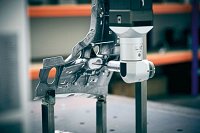Aluminum heat treatment up to 520 °C
14.12.2018
McKinsey predicts that the automotive industry will triple its aluminum consumption to 16.9 million tons by 2030. In lightweight construction, the properties can thus be specifically influenced.
 Even as a basic raw material, aluminum has many advantages over other materials: it has a low density, is therefore light, and it is durable. Perhaps the most important advantage is that most of its properties can be influenced in a targeted manner. A medium-sized company from Germany has been taking advantage of this characteristic for 20 years — by applying heat treatment.
Even as a basic raw material, aluminum has many advantages over other materials: it has a low density, is therefore light, and it is durable. Perhaps the most important advantage is that most of its properties can be influenced in a targeted manner. A medium-sized company from Germany has been taking advantage of this characteristic for 20 years — by applying heat treatment.
At three locations in North Rhine-Westphalia and Bavaria, Newalu processes around three million components in a multilayer system per year — for example body parts and engines for automobile manufacturers such as Audi, BMW, Mercedes-Benz and VW. Thanks to lightweight aluminum construction, the weight of a vehicle can be reduced by over 60 kg. Smaller engines can deliver higher performances — with lower fuel consumption and reduced pollutant emissions. Lightweight construction is not the only advantage of the material: aluminum can be cast into almost any conceivable shape. This enables complex, multifunctional components to be produced which previously had to be assembled at high cost from separate individual components. However, it is only through heat treatment that a cast component obtains the necessary strength and reduction of residual stress. Aluminum can even be used as a substitute for steel. To do this, the aluminum components have to withstand the most extreme temperatures.
Stability at extreme temperatures of over 520°C
The heat treatment process includes solution annealing, quenching and subsequent ageing. The exact nature of the process is adjusted individually to each order. "The heat treatment process begins with the development of the correct parameters, such as temperature, holding time of the castings in the furnace and the type of quenching process. These are developed in close cooperation with the development department of the automobile manufacturer," explains Martin Volpers, Managing Director of Operations at Newalu GmbH. At extreme temperatures of over 520 °C and subsequent quenching, it is decisive how the components are stored throughout the entire process. Before the aluminum components are placed in the furnace, tailor-made racks are developed. The potential deformation is captured and analyzed by 3D measurements. The racks are designed in such a way that the components do not deform during the entire heat treatment process.
Just as decisive for the success of the treatment as heating is the quenching of the components. One technology developed by Newalu is quenching in a polymer bath, which is particularly suitable for workpieces with different wall thicknesses. In a conventional water bath, thin-walled areas cool much faster than ones with thicker walls, which has a negative effect on the residual stress in the component. In the polymer bath, on the other hand, the polymer deposits like a gel on the thin, already cooled areas of the component and prevents further rapid cooling. The polymer cannot adhere to the thick-walled, still hot areas. As a result, the cooling process continues until these areas have also reached the desired target temperature. High-speed air quenching (Hisaq), which is suitable for series production, was also developed by the company and a patent application was filed in 2003. It results in uniform cooling of components without distortion. This allows thinner wall thicknesses with increased stability to be produced, which is of particular interest for car body components. After cooling, the components can be further processed or assembled directly. On the way to the assembly line, some of the desired lightweight advantages are already apparent: Weight, CO2 and costs are already saved during transport.
The transition to e-mobility is a market of the future
With electric mobility, the German automotive industry is facing one of the biggest structural changes in its history. "For lightweight aluminum construction, the change to e-mobility is an absolute market of the future," says Stefan Matthaei, Managing Director Strategy at Newalu. The volume of engine blocks to be treated will tend to increase at first, because combustion engines will be joined by hybrid units with both engine blocks and electrical components. Purely electric powertrain components show that an electric motor with integrated control and cooling has approximately the same volume and mass of aluminum as a modern engine block. "Whether we heat treat an electric motor block with integrated controls or a combustion engine block with four cylinders is irrelevant to our business model," says Matthaei. The key words in this context are battery trays or battery containers. To realize their complex structures with high crash performance requirements, die-cast aluminum is used almost exclusively. "These parts are really exciting because they are in no way inferior to the strength and stiffness requirements of structural body parts. These are very large parts, about 1.20 m long, up to 80 cm wide and cm deep. The right heat treatment know-how is particularly important here," adds Matthaei.




































